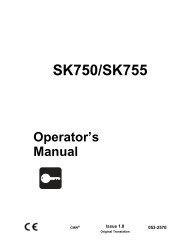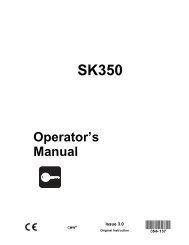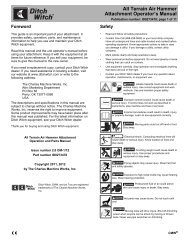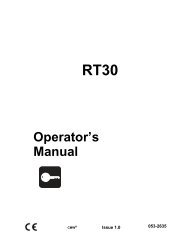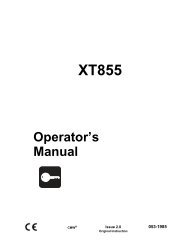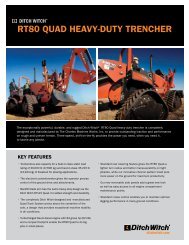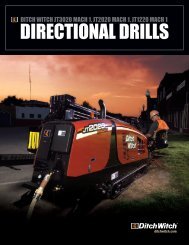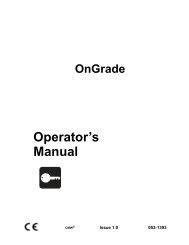You also want an ePaper? Increase the reach of your titles
YUMPU automatically turns print PDFs into web optimized ePapers that Google loves.
JT5 Operator’s <strong>Manual</strong> Systems and Equipment - 103<br />
Drilling Fluid<br />
Bentonite<br />
Bentonite is a dry powder. When properly mixed with water, it forms a thin cake on bore walls, lubricating<br />
the bore, keeping it open, and holding fluid in the bore.<br />
Some things to remember when mixing bentonite:<br />
• Use clean water free of salt, calcium, or excessive chlorine.<br />
• Use water with pH level between 9 and 10.<br />
• Use water with hardness of less than 120 ppm.<br />
• Do not use bentonite containing sand.<br />
• Mix bentonite thoroughly or it will settle in tank.<br />
• Do not mix bentonite to a funnel viscosity of over 50.<br />
For information on measuring funnel viscosity, see “Funnel Viscosity” on page 106.<br />
Mixtures<br />
Bentonite does not mix well in water containing polymer. To use both, mix bentonite first, then add polymer.<br />
When adding other products follow the order listed below.<br />
NOTICE:<br />
• If chemicals are added in the wrong order, they will not mix properly and will form clumps.<br />
• If tank contains bentonite/polymer mix and more drilling fluid is needed, completely empty tank and<br />
start with fresh water before mixing another batch.<br />
General mixing order:<br />
1. Soda ash<br />
2. Bentonite<br />
3. Polymer<br />
4. Con-Det<br />
Bore-Gel contains premixed bentonite, polymer, and soda ash. Use approximately 15 lb/100 gal (7 kg/380<br />
L) in normal drilling conditions, up to 45 lb/100 gal (21 kg/380 L) in sand or gravel and up to 50 lb/100 gal<br />
(23 kg/380 L) in rock.<br />
CMW



